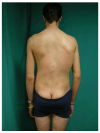Evaluation of a Primary Health Care Scoliosis Screening Program: A 9-Year Follow-Up Study
- PMID: 40507630
- PMCID: PMC12156459
- DOI: 10.3390/jcm14113870
Evaluation of a Primary Health Care Scoliosis Screening Program: A 9-Year Follow-Up Study
Abstract
Background/Objectives: Scoliosis screening aims to detect spinal deformities early and prevent progression. The Programa de Atención a la Salud de Niños y Adolescentes (PANA) in Spain includes primary care screenings at ages 5-6, 10-11, and 13-14, but its effectiveness remains unverified. First, we evaluated attendance rates in each phase. Second, a nine-year follow-up was used to determine outcomes in adolescents who completed all three phases of PANA. Methods: A retrospective-prospective cohort study was conducted. The retrospective phase analyzed records of 881 schoolchildren screened at a primary healthcare center in Lorca, Spain. The prospective phase re-evaluated 127 adolescents (94.1% of those who completed all three phases) after nine years using a standardized forward bending test (FBT) with scoliometer quantification. Results: Attendance declined from 73.2%, at age 5-6, to 20.5%, at age 13-14. Only 15.3% completed all three phases. At age 13-14, 11.1% had a positive FBT by visual assessment. Non-quantified FBT had low sensitivity (5.9%) but high specificity (96.7%). Nine years later, mean scoliometer-measured vertebral rotation was 3.6 ± 1.7° (thoracic) and 2.5 ± 1.4° (lumbar). Scoliosis suspicion (FBT > 5°) was 15.1%, but applying the FBT > 7° threshold it was reduced to 4%. Conclusions: The PANA program has limited effectiveness due to low attendance and lack of scoliometer use. Visual FBT without quantification increases false positives, reducing diagnostic accuracy. It is recommended that preventive assessments be conducted in schools by primary care physicians. Training in the use of the scoliometer is essential to improve scoliosis detection.
Keywords: PANA program; adolescent health; primary care; scoliometer; scoliosis screening.
Conflict of interest statement
The authors declare no conflicts of interest.
Figures





References
-
- Grivas T.B., Vsiliadis E.S., Rodopoulos G. Aetiology of idiopathic scoliosis. What have we learned from school screening? Stud. Health Technol. Inform. 2008;140:240–244. - PubMed
-
- Álvarez L.I., Nuñez A. Escoliosis idiopática. Rev. Pediatr. Aten. Primaria. 2011;13:135–146.
LinkOut - more resources
Full Text Sources

